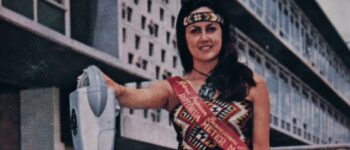1966: Rotorua Meter Maid
July 4, 2022
By AHNZ

Local Government realised in the 1950s that it could exploit owners of parked cars for revenue. From this came the first species of Meter Maid. A curious phenomena. They were a combination of the government flirting with you and the government stealing money from you for not having your vehicle in motion.
In the holiday season of ’65/’66 Rotorua reacted to the government kleptocrats by adopting the innovative idea that had been in use on Australia’s Gold Coast since at least one holiday season before. Where government Meter Maids stole the new capitalist Meter Maids gave.
Having to interrupt or cut your shopping visit short for the sake of moving your car or dropping coins into government machines was bad for commerce. So, the second species of Meter Maid was created by business at their own expense. Young women, like 15yo June Northcroft (image, left) strutted about attractively and actually put money into parking meters so shoppers did not have to!
The Maori Meter Maid even visited other cities to provide Meter Maid duties to promote Rotorua tourism. This included Christchurch and even an exchange period with one of the gold-bikini Queenslander Meter Maids. Other locations such as Whangarei and Takapuna also had the more attractive and giving Maids in contrast to the nasty government ones who took money from you. The difference with Rotorua’s was that the Maids dressed up in re-imagined ‘Plastic Maori’ garb. This, of course, is nothing shameful to a Rotorua Maori who has willingly been creating psudo-Maori displays this way for many generations so that paying outsiders could access their culture. If the Plastic Maori is unsophisticated it’s really a reflection on how much authenticity the tourists are willing to digest.
“The council [Wellington] realised after World War II that charging for parking would actually be a good source of revenue as well as helping to ease the traffic problem. In 1953, it asked for 400 parking meters. ” – Maids in sky blue minded the meters, Stuff (2015)
“Young Māori meter maids (who collect money from parking meters) pose in Māori costume in Rotorua in 1966. The availability of air travel in the 1960s saw a new influx of international tourists to New Zealand. The Rotorua City Council tried to capitalise on the new visitors by outfitting its meter maids in Māori dress.” – Government history website incorrectly attributing the Council and the direction of cash flow between meter and maid. Don’t get your history from government websites. Ref. teara.govt.nz
“A pretty Maori girl from Rotorua spent all day yesterday going around the streets of Christchurch feeding expired parking meters.” – Maori MeterMaid Feeds City Meters, Press (1966,) Papers Past
“Rotorua Retailers’ Association, Mr T. R. Cato, said today that the meter maids employed during the holiday season had been so successful that he would suggest to the association that one maid be employed full-rime.” – JOB MAY BE PERMANENT Maori Meter Maid, Press (1966,) Papers Past
“Māori perpetuated the myth by posing in clothes they wouldn’t normally wear to appeal to the European market..” – Ref. 1900s: Fake Plastic Maoriland, AHNZ
 Of great interest is the openly sexual and flirtatious nature of sixties New Zealand. The previous post-war Conformity would not have tolerated mixing such radiant fertility signs in secondary sexual characteristics being openly displayed in public or associated with their towns and commercial centres. The new Innovation pushing out the old generations served the new coming-of-age Kiwis: The Baby Boomers. We see the same thing in the Shantydown Can-Can girls from the same time period.
Of great interest is the openly sexual and flirtatious nature of sixties New Zealand. The previous post-war Conformity would not have tolerated mixing such radiant fertility signs in secondary sexual characteristics being openly displayed in public or associated with their towns and commercial centres. The new Innovation pushing out the old generations served the new coming-of-age Kiwis: The Baby Boomers. We see the same thing in the Shantydown Can-Can girls from the same time period.
As always, this late 1960s era of revealing fashions hit a wall. Until 1973 New Zealand was having an economic boom then ‘The End of the Golden Weather’ struck in the form of a so-called ‘Oil Shock.’ Hemlines came down as people started dressing more conservatively to better endure the economic downturn. Ref. 1973: Early Seventies ‘Oil Shock’ Hemlines
Unfortunately, the Hemline Index as an economic indicator doesn’t work so well right now (early 2020s) due to the adoption of skin-tight clothing such as ‘yoga pants’. Women can (and do) now present or reveal very nearly as much of their bodies as if they were naked without moving the hem. They broke the Index! The gateway to this occurred around 2018 when our women started wearing very short jeans or long ones cut away to the seams; Full hem but also totally revealing. Body-hugging garb accentuating secondary sexual characteristics wasn’t far behind. An improved index would have to be not about hemline but about how much of the body is on display. Go back far enough and the calibration was between a woman’s ankle being shown or not, or even if her head was covered up in a bonnet (our Colonial ‘hijab’) or not.
The revealing way women are dressing in 2022 shows us that we have not had an economic crash yet but that we are flying headlong into one.
—
Image ref. Māori Meter Maid, Maori TV (2015)
Image ref. Takapuna Meter Maid Susan Dorrington, Press (1966,) Papers Past; Enhanced by AHNZ
 Like Comment Share
Like Comment Share





